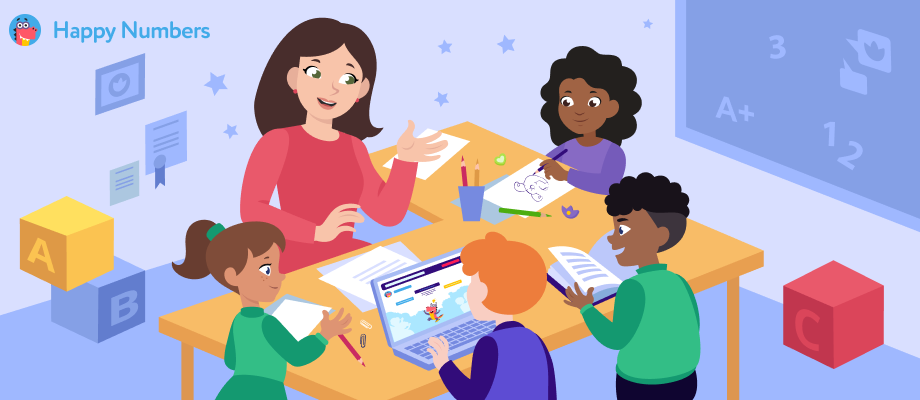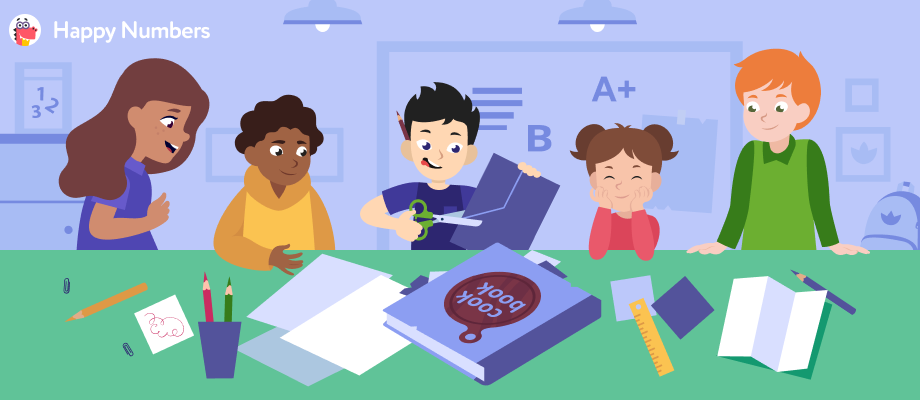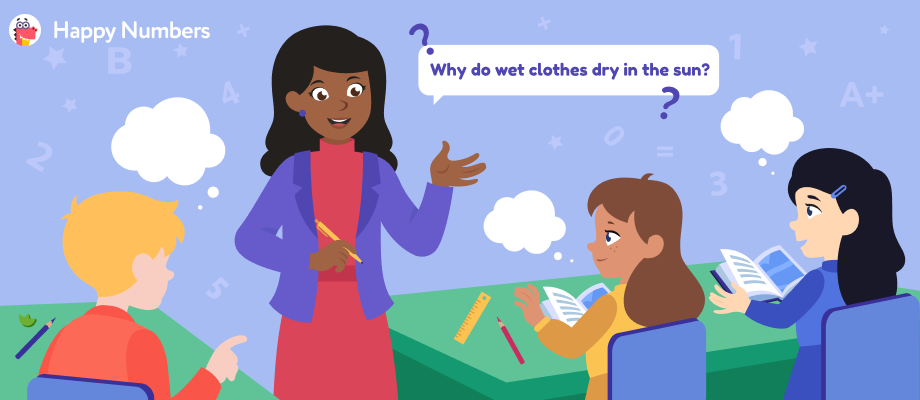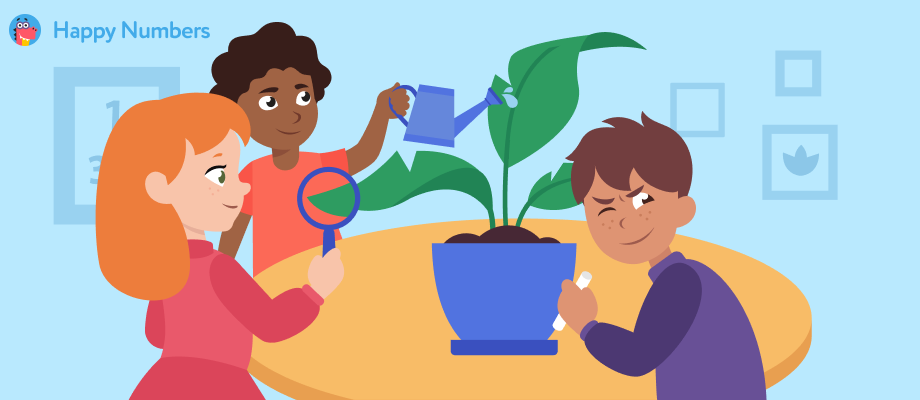List Of Teaching Methodologies Primary School
If you are looking for new tools to diversify your daily classroom activities, register as a teacher on the website to start a free trial period (only this week)! Happy Numbers offers a curriculum in which students study mathematical procedures consistently. They increase and deepen knowledge using descriptive visual models, supplemented by manipulative mechanics and expressive animation.
Your Guide to the Top Teaching Methodologies in Primary School
In this article we have listed and made a review of the most popular approaches that might be useful for teachers.
The list of teaching methodologies you could use with elementary-aged students is a long one. An approach effective for one teacher may not necessarily be useful for another because every method uses different tools and techniques for achieving common educational goals. That’s why many teachers try to extract some ideas from different approaches, mixing and incorporating them into one unique teaching approach depending on the students’ and school’s needs and other circumstances.
Besides that, keep in mind that no matter which of the methods listed below a teacher chooses, nowadays it seems quite difficult to implement any approach without relying on technology. That is one of the reasons why Happy Numbers was created: to help teachers incorporate their ideas into one digitally-guided learning experience and let students benefit from it, without losing their interest.
Are you ready to learn more about some of the best methods of teaching? Check out our list and analysis below to learn which methods have the research to back them up:
List Of Teaching Methods

1. Teacher-Centered Instruction
Recognized as the most conventional approach, the teacher-centered methodology is based on the idea that the teacher has the main responsibility in the learning environment. Teachers are in charge of the classroom and direct all activities. Typically, in this approach, students are seated at individual desks that face the teacher. While group work may take place, most classroom time is spent with the teacher explaining concepts and assigning individual work. In other words, students passively absorb the information while the teacher actively delivers it.
Advantages:
1. It highlights the importance of the teacher’s role as facilitator. Although the teacher-centered approach has been criticized for encouraging passive learning, no one can deny that students need the assistance of a teacher to develop their skills.
2. Having been built on behavioral theory, this teaching method facilitates control over changes in student behavior through direct instruction. It might be helpful to use the core of this approach and modify it depending on the teacher’s and students’ needs, gradually shifting the focus from the former to the latter.
1. It highlights the importance of the teacher’s role as facilitator. Although the teacher-centered approach has been criticized for encouraging passive learning, no one can deny that students need the assistance of a teacher to develop their skills.
2. Having been built on behavioral theory, this teaching method facilitates control over changes in student behavior through direct instruction. It might be helpful to use the core of this approach and modify it depending on the teacher’s and students’ needs, gradually shifting the focus from the former to the latter.
Disadvantages:
1. Critics cite lack of stimulation student motivation. Indeed, the teacher-centered method, used blindly, may not allow students enough freedom of mind and creativity.
2. It is poor at promoting analytical thinking and problem solving skills. Not having enough opportunities for students to make their own choices may result in lack of decision making skills and even inability to think critically.
1. Critics cite lack of stimulation student motivation. Indeed, the teacher-centered method, used blindly, may not allow students enough freedom of mind and creativity.
2. It is poor at promoting analytical thinking and problem solving skills. Not having enough opportunities for students to make their own choices may result in lack of decision making skills and even inability to think critically.
This and other comparativist theories developed and proven by many scientists are described and analyzed in “A Comparison of Teacher-Centered and Student-Centered Approaches in Educational Settings” article.
2. Small Group Instruction

Small group instruction (SGI) usually follows whole group instruction and provides students with a reduced student-teacher ratio, typically in groups of four to six students. SGI allows teachers to work more closely with each student on a specific learning objective, reinforce skills learned in whole group instruction, and check for student understanding. This teaching method is based on constant activities around workstations: groups working with the teacher and groups working independently on varied activities, such as using manipulatives or computer/online resources.
If you liked the article and want to find more effective small-group instruction strategies for your lessons, check out the activities and ideas provided by Happy Numbers and start a free trial (which is available only this week) right now!
Speaking of digital resources, they have been showing their huge potential lately, and Happy Numbers is no exception. The platform has been effectively used by many experienced teachers to improve their small group instructional techniques. The Happy Numbers curriculum perfectly integrates the main principles of the approach and helps teachers to plan their lessons accordingly.
Happy Numbers meets each student's individual needs, provides direct instruction, and always keeps them in their zone of proximal development, which allows them to independently close learning gaps. Moreover, its digital framework keeps students engaged throughout the whole course, letting them work independently and carefully monitoring their progress.
Happy Numbers meets each student's individual needs, provides direct instruction, and always keeps them in their zone of proximal development, which allows them to independently close learning gaps. Moreover, its digital framework keeps students engaged throughout the whole course, letting them work independently and carefully monitoring their progress.
Advantages:
1. Lessons are adapted to each student’s level. This allows teachers to provide targeted, differentiated instruction to small groups of students in a natural way. It helps the instructor to more closely evaluate what each student is capable of and construct strategic plans around the assessments.
2. It promotes students’ social adaptation skills. Students who find it difficult to ask questions and participate in a large group setting may benefit from working in a small group setting, where they feel more at ease and less overwhelmed.
1. Lessons are adapted to each student’s level. This allows teachers to provide targeted, differentiated instruction to small groups of students in a natural way. It helps the instructor to more closely evaluate what each student is capable of and construct strategic plans around the assessments.
2. It promotes students’ social adaptation skills. Students who find it difficult to ask questions and participate in a large group setting may benefit from working in a small group setting, where they feel more at ease and less overwhelmed.
Disadvantages:
1. It takes more time and effort to prepare materials and organize workstations for each student group. Teachers need to think through each type of activity that will be provided at workstations: they should be equally engaging and effective.
2. Students might feel pressure to always be involved, always contributing to lessons, and always taking some kind of role in group work.
3. Student-Centered / Constructivist Approach

As we consider shifting the focus from teacher to students, the rest of the approaches from this list are considered to be student-centered or constructivist. With the development of the educational sphere and society in general, the idea of a student-centered approach has become more popular, and there are good reasons for that. Student-centered classrooms include students in planning, implementation, and assessments. Involving the learners in these decisions places more responsibility and ownership on them rather than on the teacher. Also, teachers must become comfortable with changing their leadership style from directive to consultative. Meanwhile, students may work in small groups, access centers, and move about the classroom freely.
We hope that the ideas shared in this article will help you and your students to succeed in this potentially challenging topic. If you do find these tips helpful, check out what Happy Numbers offers its users by setting up your class and starting a free trial which is available only this week!
Advantages:
1. Students play a more active role in their learning and develop a sense of responsibility.
2. Thanks to teachers avoiding transmission of knowledge directly, students have a chance to stimulate their analytical thinking, by “making sense of what they are learning by relating it to prior knowledge and by discussing it with others,” according to American educational psychologist J. Brophy.
1. Students play a more active role in their learning and develop a sense of responsibility.
2. Thanks to teachers avoiding transmission of knowledge directly, students have a chance to stimulate their analytical thinking, by “making sense of what they are learning by relating it to prior knowledge and by discussing it with others,” according to American educational psychologist J. Brophy.
Disadvantages:
1. There is a risk of facing some behavioral problems by giving students independence, especially when it comes to young children. To avoid such problems, teachers must lay a groundwork by creating a model of correct behavior: having the freedom to do what you want means being ready to take responsibility for the process and the results.
2. This method works best when the instructor makes the lesson interesting. Without this, students may get bored, their minds may wander, and they may miss key information.
The student-centered approach can be difficult for teachers to master or perfect, and it doesn´t always guarantee a 100% outcome. However, the results can be very positive if teachers still employ the approach partially, blending these techniques with other types of lessons.
4. Project-Based Learning

A relatively new teaching method, project-based learning falls within the student-centered approach. As the name suggests, in project-based learning students complete projects. However, these are big, meaty projects in which students acquire knowledge, research, think critically, evaluate, analyze, make decisions, collaborate, and more.
Typically, projects are created in response to an open-ended question such as “How can our school be greener?” or “How was our city planned in the past and how could it be planned in the future?” Another important part of the projects is that they relate to real-world problems. The projects shouldn’t just apply to the classroom but have an impact, too. For example, students might make a radio show for the whole school to hear. Or, they might write a letter to the town council and attend a meeting to express an opinion.
Advantages:
1. Between projects, the teacher may provide scaffolding and smaller bite-sized projects to help build skills such as how to research, how to solve division problems, how to write a letter, etc. Thus, students build on what they know by asking questions, investigating, interacting with others, and reflecting on these experiences.
2. Cooperative learning is enhanced by letting students organize their work in groups.
1. Between projects, the teacher may provide scaffolding and smaller bite-sized projects to help build skills such as how to research, how to solve division problems, how to write a letter, etc. Thus, students build on what they know by asking questions, investigating, interacting with others, and reflecting on these experiences.
2. Cooperative learning is enhanced by letting students organize their work in groups.
Disadvantages:
1. It’s quite time consuming and requires good classroom management skills (from equipment availability to organizing and controlling the usage of it).
2. Students without experience in group work may have difficulties adapting roles and negotiating compromise.
1. It’s quite time consuming and requires good classroom management skills (from equipment availability to organizing and controlling the usage of it).
2. Students without experience in group work may have difficulties adapting roles and negotiating compromise.
5. Montessori

This type of teaching is based on a methodology that’s over 100 years old. Yet, it continues to offer a novel approach to creating a student-centered classroom.
Today, the Montessori method is most popular in preschools, kindergartens, and lower elementary grades. In this method, the teacher prepares an ideal classroom environment full of activities that children may pick from to work on. Moreover, the teacher guides the children to ensure that they choose an adequate number of lessons from all of the subject areas.
The Montessori method also encourages the use of “materials” or carefully curated objects designed for learning. For example, there are trays containing different types of triangles or cards with definitions explaining the parts of a bird. Furthermore, the Montessori method includes areas of the curriculum that teach social skills and practical life skills, such as cooking and cleaning.
Advantages:
1. Strong intrinsic motivation and a strong sense of responsibility are important qualities that the Montessori method strives to instill in students. Children often work independently and have their choice of what to work on and where to work in the classroom.
2. It creates a positive learning environment. The multi-age learning environment is unique and a key factor to this educational method. Younger children have a great opportunity to develop their social, communication, leadership, and emotional skills by working with older children. Older children also benefit from this approach.
1. Strong intrinsic motivation and a strong sense of responsibility are important qualities that the Montessori method strives to instill in students. Children often work independently and have their choice of what to work on and where to work in the classroom.
2. It creates a positive learning environment. The multi-age learning environment is unique and a key factor to this educational method. Younger children have a great opportunity to develop their social, communication, leadership, and emotional skills by working with older children. Older children also benefit from this approach.
Disadvantages:
1. It can be expensive. For Montessori schools, it is very hard to keep their prices low.
2. Some teachers and students may find it difficult to get used to the looseness of the curriculum compared to familiar methods of teaching. It’s important to keep that in mind before deciding to incorporate some ideas of Montessori or even implement it into teaching.
1. It can be expensive. For Montessori schools, it is very hard to keep their prices low.
2. Some teachers and students may find it difficult to get used to the looseness of the curriculum compared to familiar methods of teaching. It’s important to keep that in mind before deciding to incorporate some ideas of Montessori or even implement it into teaching.
Here’s a good scientific review written by Chloë Marshall, one of the researchers of University College London, in which she describes Montessori education’s effectiveness and key elements of it that are shared with other educational methods for those who are interested and want to start implementing it into their teaching.
6. Inquiry-Based Learning

What if learning was question-driven? This is exactly what inquiry -based learning is about: it engages students by making real-world connections through exploration and high-level questioning.
Still looking for some useful ideas to incorporate into your lesson plans? Your own “digital assistant” will not only help you diversify usual classroom activities but also will help optimize instruction and provide individual student data. Click “I am a teacher” on Happy Numbers’ website to get started right now. Free trial is available only this week!
Advantages:
1. Teachers guide students to develop critical thinking and problem solving skills. To learn these skills, the teacher helps students think through their processes, teaches them possible approaches, and encourages them to try various methods.
2. Students are encouraged to fail as a part of the process and then improve their performance in subsequent activities.
3. Instead of repeating answers students have been taught, students learn to seek their own answers to questions. So, students develop strong research skills.
Disadvantages:
1. Because students are always encouraged to speak up, participate, and not be afraid to fail, there is always a risk of embarrassing students who may not be quick thinkers (or who suffer from learning disabilities and processing issues). This leads to a higher level of anxiety and loss of motivation.
2. It may result in poorer standardized testing performance. When too much time is dedicated to student inquiries, there’s always the risk that important “core” topics could be left out. Naturally, this hurts standardized testing performance.
1. Because students are always encouraged to speak up, participate, and not be afraid to fail, there is always a risk of embarrassing students who may not be quick thinkers (or who suffer from learning disabilities and processing issues). This leads to a higher level of anxiety and loss of motivation.
2. It may result in poorer standardized testing performance. When too much time is dedicated to student inquiries, there’s always the risk that important “core” topics could be left out. Naturally, this hurts standardized testing performance.
Still, one may find some useful techniques and ideas of inquiry-based learning for carefully implementing them into the lesson and benefiting from them, as the approach gives a lot of opportunities to promote students’ problem solving abilities
7. Flipped Classroom

The concept of delivering online lectures that students can view from home to substitute lecturing in the classroom is known as flipped learning. The letters FLIP represent the four pillars included in this type of learning: Flexible environment, Learning culture shift, Intentional content, and Professional educator. This technique, in theory, allows for more time in class to be devoted to active learning rather than instruction.
Advantages:
1. Students have more control over their learning. When viewing video content or other materials at home, students have the option of learning at their own pace.
2. It promotes student-centered learning and collaboration.
1. Students have more control over their learning. When viewing video content or other materials at home, students have the option of learning at their own pace.
2. It promotes student-centered learning and collaboration.
Disadvantages:
1. It is difficult to implement: unequal access to technological resources disadvantages certain populations.
2. Being based mostly on auditory perception of students, it leads to less effective comprehension.
3. It depends highly on students’ compliance: the approach assumes that students will complete the out-of-class preparation and always be prepared for participation in class. There’s a risk though that not all students will always be prepared for the lesson.
1. It is difficult to implement: unequal access to technological resources disadvantages certain populations.
2. Being based mostly on auditory perception of students, it leads to less effective comprehension.
3. It depends highly on students’ compliance: the approach assumes that students will complete the out-of-class preparation and always be prepared for participation in class. There’s a risk though that not all students will always be prepared for the lesson.
Multiple case studies prove that the positive effect of this method outweighs shortcomings that may be easily avoided through the use of a partially flipped classroom. We’re sure that teachers are likely to find some useful techniques of flipped learning and incorporate them into their own lessons.
8. Cooperative Learning

As the name suggests, cooperative learning involves a lot of group work. However, it also requires a lot of structure and intervention on the part of the teacher to make learning as effective as possible. Some commonly used cooperative learning strategies include “think-pair-share.” Discussions in small groups or pairs can also be effective, as can a “jigsaw” approach. In the jigsaw model, students are broken into small groups to read or learn from a certain perspective. Then, changing their groups, members spread the information and share it with others.
Advantages:
1. It improves social skills through cooperative work, recreating real-world work situations in which collaboration and cooperation are required. One of the most vivid results of cooperative learning is described in American psychologist and professor of the John Hopkins University Robert E. Slavin’s essential work “Cooperative learning: Theory, Research, and Practice”.
2. It improves critical thinking: during the group work process, students will express their opinions or ideas with the other students in the group providing feedback. This feedback to each student will include critique as well as the interpretation of the opinions or ideas expressed.
1. It improves social skills through cooperative work, recreating real-world work situations in which collaboration and cooperation are required. One of the most vivid results of cooperative learning is described in American psychologist and professor of the John Hopkins University Robert E. Slavin’s essential work “Cooperative learning: Theory, Research, and Practice”.
2. It improves critical thinking: during the group work process, students will express their opinions or ideas with the other students in the group providing feedback. This feedback to each student will include critique as well as the interpretation of the opinions or ideas expressed.
Disadvantages:
1. There may be difficulties with distributing social roles among group members and, as a result, the detachment of one student from the group. There are risks of possible conflicts between group members, which demands more attention from the teacher.
2. Students working in the same group may have different speeds of learning.
1. There may be difficulties with distributing social roles among group members and, as a result, the detachment of one student from the group. There are risks of possible conflicts between group members, which demands more attention from the teacher.
2. Students working in the same group may have different speeds of learning.
9. Personalized Education
Personalized education takes the student-centered approach to a new level by, as much as possible, responding to each individual learner’s unique needs, strengths, and weaknesses. Each student gets a learning plan that's based on what he or she knows and how he or she learns best. Through individualized instruction, learning is tailored to the student. It provides numerous and yet-to-be-discovered advantages for both teachers and students.
Advantages:
1. Personal attention is given to ensure that every child develops his or her intellectual and creative talents.
2. Studying in a supportive and caring environment promotes respectful student-teacher relationships and even teacher partnership with parents.
1. Personal attention is given to ensure that every child develops his or her intellectual and creative talents.
2. Studying in a supportive and caring environment promotes respectful student-teacher relationships and even teacher partnership with parents.
Disadvantages:
1. It can be time- and organization-demanding: teachers have to modify their pace, do a lot of preparation, and learn to comprehend and attend to each student's needs.
What Is the Best Method of Teaching?
There is no “best” method of teaching. However, many researchers today agree that including more student-centered learning approaches in the classroom can improve learning. Using only a teacher-centered approach leaves out many skills and learning opportunities for students. Yet, there may still be space for teacher-centered learning for some specific topics and learning objectives. However, teacher-centered learning shouldn’t be the only strategy in your teacher toolbox.
The bottom line is that each teacher needs to find a teaching style that fits his or her personality. An effective teacher is a passionate teacher who is confident in what they’re doing! So, if any of the strategies on this list of teaching methods intrigues you, why not look into it a bit more? You might discover a new method that motivates your students and improves their learning and your teaching experience!
Are you looking for a new tool in your teacher toolbox for teaching maths in a fun, engaging way that builds a deep understanding of the subject? Try Happy Numbers (it’s free to try!) and watch your students grow 1.5 grade levels in just one school year!
